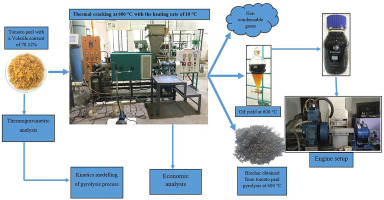Journal of Cleaner Production ( IF 9.7 ) Pub Date : 2020-01-11 , DOI: 10.1016/j.jclepro.2020.120115 K. Midhun Prasad , S. Murugavelh

|
Pyrolysis of tomato peel waste in an indigenous Auger reactor is reported. Tomato peel was subjected to elemental analysis and physicochemical characterisation. The higher heating value of the tomato peel was estimated to be 22.50 MJ kg−1. Thermogravimetric analysis of tomato peel was performed to estimate the temperature of pyrolysis process. Thermal cracking of tomato peel was carried out at different temperatures ranging from 450 °C to 650 °C. The bio oil yield was found to 14%, 17.5%, 32%, 40% and 36% at 450 °C, 500 °C, 550 °C, 600 °C and 650 °C respectively. Kinetic modelling of the tomato peel pyrolysis was performed with three different model free methods to evaluate the activation energy. The activation energy of tomato peel pyrolysis at different heating rates, 5 °C min−1, 10 °C min−1, 15 °C min−1, 20 °C min−1 and 25 °C min−1 were reported to be 112.7 kJ mol−1, 113.85 kJ mol−1 and 234.47 kJ mol−1 respectively by Kissinger, Kissinger Akahira Sunose and Ozawa Flynn Wall models. Tomato peel oil was subjected to Gas chromatography - Mass spectroscopy and Fourier transform infrared spectroscopy analysis to determine the compounds and functional groups. The kinematic viscosity of the tomato peel oil was found to be 11.82 cSt. The flash point of the tomato peel oil was estimated to be 94 °C. Different blends of tomato peel oil and diesel were subjected to testing in a 4-stroke water cooled open chamber diesel engine to evaluate the performance and emission characteristics analysis. The Brake thermal efficiency of 5% blend of tomato peel oil was estimated to be 31.5% under full load condition. Carbon Monoxide emissions of tomato peel oil blends were found to be lesser in comparison with diesel fuel. Techno-economic analysis of the tomato peel pyrolysis was also reported.
中文翻译:

番茄皮热解的实验研究和动力学:柴油机中生物油混合物的性能,燃烧和排放特性
据报道,在本地的俄歇反应器中将番茄皮废料热解。对番茄皮进行元素分析和理化鉴定。番茄皮的更高的热值估计为22.50 MJ kg -1。进行番茄皮的热重分析以估计热解过程的温度。番茄皮的热裂解是在450°C至650°C的不同温度下进行的。发现在450℃,500℃,550℃,600℃和650℃下生物油产率分别为14%,17.5%,32%,40%和36%。用三种不同的无模型方法对番茄皮热解进行动力学建模,以评估其活化能。番茄皮热解的活化能在5°C min -1下的不同加热速率下,10℃分钟-1,15℃分钟-1,20℃分钟-1和25℃分钟-1据报道,112.7千焦摩尔-1,113.85千焦耳摩尔-1和234.47千焦耳摩尔-1基辛格(Kissinger),基辛格(Kissinger)Akahira Sunose和小泽弗林(Ozawa Flynn Wall)模特。对番茄皮油进行气相色谱-质谱和傅立叶变换红外光谱分析,以确定化合物和官能团。番茄皮油的运动粘度为11.82cSt。番茄皮油的闪点估计为94°C。番茄果皮油和柴油的不同混合物在4冲程水冷开室柴油机中进行了测试,以评估性能和排放特性分析。在满载条件下,估计5%番茄皮油混合物的制动热效率为31.5%。发现与柴油相比,番茄皮油混合物的一氧化碳排放量要少。











































 京公网安备 11010802027423号
京公网安备 11010802027423号